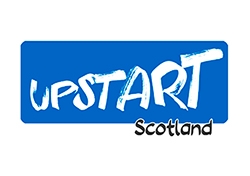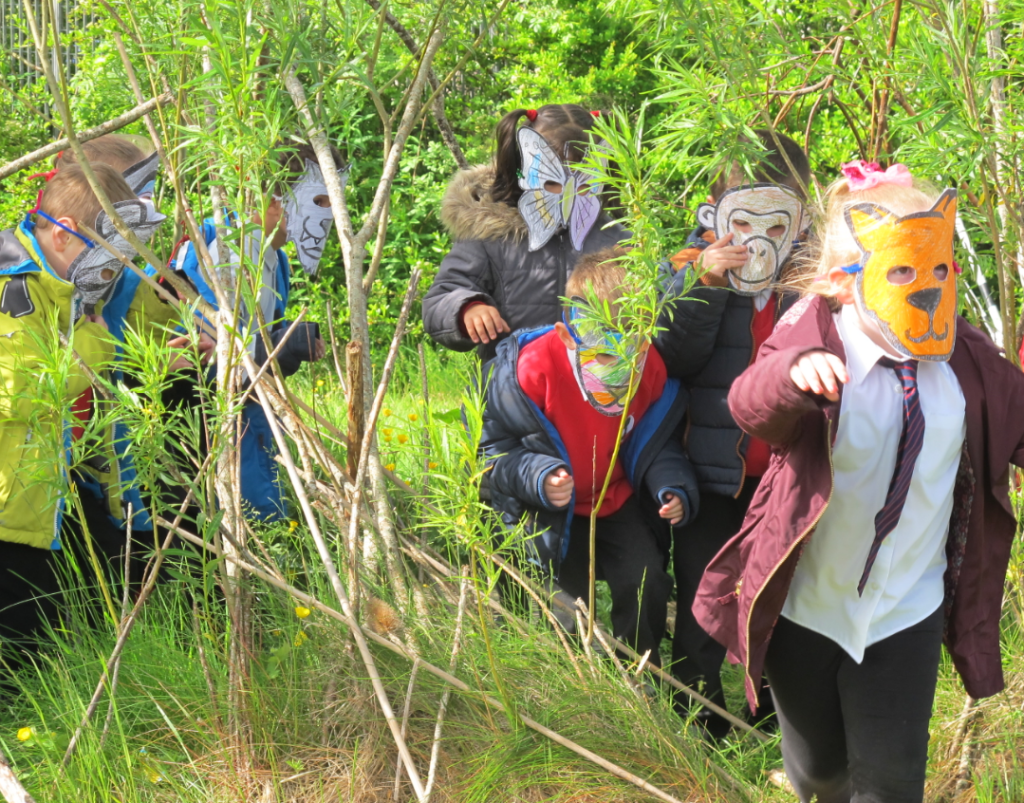The first of two blogs about creativity, education for sustainability and PLAY by Emily Reid, Artistic Director and Founder of Eco Drama
What does the phrase Out to Play mean to you? What images or memories does it conjure? You might think back to your childhood and time spent playing outside after school, or at weekends and during the school holidays. Where did you go – what did you do?
You might also think of your time at school, the time ‘in between’ lessons – playtimes and lunch times, when you and your fellow classmates were released into the playground to take a break from learning – to play freely in an unstructured manner either with your friends, or on your own. Whatever you think of and wherever and whenever you went ‘out to play’, hopefully thinking about it conjures for you a sense of freedom, possibility and adventure.
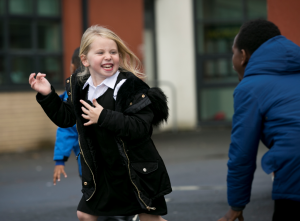 It is these qualities of freedom, possibility and adventure which embody ‘Out to Play’, a creative outdoor learning project first piloted by Eco Drama in 2015 and which is now in its sixth year of delivery.
It is these qualities of freedom, possibility and adventure which embody ‘Out to Play’, a creative outdoor learning project first piloted by Eco Drama in 2015 and which is now in its sixth year of delivery.
The Out to Play project began with a question – how can we develop the role of the arts and creativity in outdoor learning, particularly in urban areas? Around 2014, I was having conversations with teachers in Glasgow who spoke of their remit to develop outdoor learning with pupils, with one teacher poignantly asking ‘how can I develop outdoor learning and promote nature connection in a concrete playground?!’
I started to think about Eco Drama’s specialisms, drama, theatre and storytelling, and how these could be developed and advanced within the world of Outdoor Learning & Learning for Sustainability, and specifically, what role imagination could play, particularly in urban playground spaces with little to no green spaces. If there aren’t any trees, could we imagine a forest? If there aren’t any noticeable signs of wildlife, how could we ‘become animal’ in playground adventures?
Along with lead drama artist Ben Mali, we started to think about the ‘What Is’ versus What If’ as a way to begin. In Out to Play the ‘IS’ is the everyday classroom world & ‘IF’ the re-imagined outdoor world. What IF our playground space looked like this…
Of course, many schools in urban areas do have trees and lots of green space (or have, like Westercraigs Nursery in the east end of Glasgow, developed their concrete spaces into creative ‘wonderworlds’) and these are equally great settings to incorporate the arts.
However, for those who still have wide stretches of concrete around their school, creating a newly imagined world together at the start of an Out to Play residency not only helps to stimulate the imagination and provide a rich setting for the stories and creative, play-based activities to come but, by honing in on the playground space and exploring its qualities in more detail, we encourage participants to notice and appreciate the nature on their doorstep. For even in a concrete playground, nature exists when looking closely.
Why the arts? The need to nurture creativity and play in learning
We also wanted to explore the idea that everyday learning experiences can incorporate the arts, creativity and play in one holistic way of working. In the case of Out to Play, with a particular focus on learning for sustainability. For it is when working in the realm of arts-based interdisciplinary learning that so many possibilities unfold and we can really nurture and develop children’s creativity, imagination, confidence, health and well-being, literacy, emotional and social development, as well as skills, knowledge and understanding within their learning experiences.
Perhaps most notably, the arts engage children emotionally as well as intellectually in their learning and play, and the development of emotional intelligence in our children is the gateway to being, and becoming, well-rounded, healthy individuals. As the late Ken Robinson said: “Creativity is as important now in education as literacy, and we should treat it with the same status.”
In this light, we must create the conditions for creativity to thrive in all levels of education, and the world of outdoor learning is rich in possibilities for imaginative enquiry. As educators and facilitators, we have a significant opportunity to create the circumstances where children’s natural creative abilities show themselves.
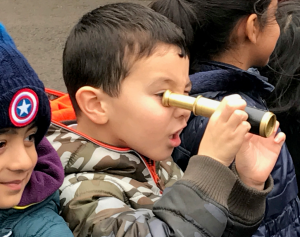 As advocates for the power of story, drama and creative play, Eco Drama have seen first-hand the benefits of this way of working. Nurturing children’s creativity is key to helping them live their best lives during early childhood and beyond. Through creative learning, through play and time spent outdoors in nature, we set the scene for children to be children, enabling them to celebrate the wonder of being three, four or five – not simply preparing them for school. We believe this helps to lay the foundations for a healthy, creative, resilient journey into adulthood.
As advocates for the power of story, drama and creative play, Eco Drama have seen first-hand the benefits of this way of working. Nurturing children’s creativity is key to helping them live their best lives during early childhood and beyond. Through creative learning, through play and time spent outdoors in nature, we set the scene for children to be children, enabling them to celebrate the wonder of being three, four or five – not simply preparing them for school. We believe this helps to lay the foundations for a healthy, creative, resilient journey into adulthood.
What is Out to Play?
Drama Artists from Eco Drama collaborate with partner primary schools and nurseries to design and deliver five-week long creative outdoor learning residencies tailored to the unique surroundings of each school playground, with a goal to notice and appreciate nature within urban environments and deepen children’s connection with the natural world.
Out to Play uses the arts – Storytelling, Drama and Creative Play, to bring to life nature themes and learning for sustainability topics to create meaningful, creative outdoor learning experiences. The drama artists are also storytellers and incorporate engaging stories from around the world, which inspire wonder, curiosity, care and respect for nature.
The project has a strong CPD element including twilight training sessions in drama and storytelling skills, plus teacher led weeks where staff design and deliver their own ‘Out to Play’ session, incorporating arts-based learning, creativity and play with a nature theme or topic, and the project’s legacy is that schools and nurseries continue to deliver arts-based ‘Out to Play’ sessions after the project ends. In many partner schools, teachers have gone on to use storytelling and drama across all areas of the curriculum, and now take their children outdoors to learn on a more regular basis.
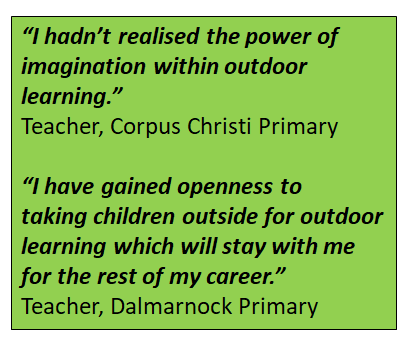 Six years on from the pilot in 2015, the Out to Play project has to date worked in-depth with 25 primary schools and nurseries across Glasgow, reaching over 5,000 children and almost 600 teachers and early years practitioners with arts-based outdoor learning residencies delivered in school playgrounds. We have also delivered extensive CPD sessions across Scotland and produced three hard copy Out to Play resource packs tailored to primary and early years practitioners that have been used in settings across Scotland and the UK and as far away as Canada and Australia. Due to ongoing interest in the project, Out to Play will now extend for a further 2 years throughout 2021-2023 and we are delighted to continue building on the momentum of the work.
Six years on from the pilot in 2015, the Out to Play project has to date worked in-depth with 25 primary schools and nurseries across Glasgow, reaching over 5,000 children and almost 600 teachers and early years practitioners with arts-based outdoor learning residencies delivered in school playgrounds. We have also delivered extensive CPD sessions across Scotland and produced three hard copy Out to Play resource packs tailored to primary and early years practitioners that have been used in settings across Scotland and the UK and as far away as Canada and Australia. Due to ongoing interest in the project, Out to Play will now extend for a further 2 years throughout 2021-2023 and we are delighted to continue building on the momentum of the work.
Out to Play in a Pandemic
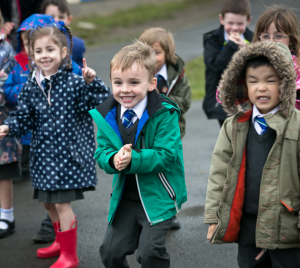 The pandemic has of course highlighted the need to take learning outdoors, but we must be clear that the benefits stretch far beyond effective infection control. Despite having so much else to contend with, the staff and schools that went ‘Out to Play’ with the project in 2020 gave us immense hope that the education system is progressing towards one in which creativity, the arts and outdoor learning are really valued at the core.
The pandemic has of course highlighted the need to take learning outdoors, but we must be clear that the benefits stretch far beyond effective infection control. Despite having so much else to contend with, the staff and schools that went ‘Out to Play’ with the project in 2020 gave us immense hope that the education system is progressing towards one in which creativity, the arts and outdoor learning are really valued at the core.
Looking forward, we have our first ever winter Out to Play residencies booked, showing a positive progression in teachers attitude to getting outdoors at any time of year, and also, after Eco Drama launched the Early Years Out to Play Resource Pack in February 2021, we have attracted the interest of Glasgow City Council and are rolling out copies of the pack to every nursery in the city. Staff will also have the opportunity to participate in a series of Early Years Out to Play CPD webinars.
We are excited and honoured to have our work reach practitioners on this scale and to see the arts and creativity being valued within the world of outdoor learning at council leadership level. We look forward to contributing more to the burgeoning outdoor learning movement across the city and Scotland over the coming years, and continuing to champion the role of the arts and creativity in this field.
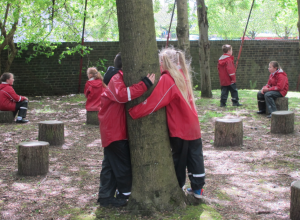 To conclude, it is always encouraging when a school or nursery gets on board with the Out to Play project, and really commits to developing an arts-based approach to outdoor learning. But when faced with all of the challenges of a pandemic, we are finding it even more encouraging to see interest in the project remain steadfast, and increase. The nursery and school staff we are working with currently are showing admirable leadership that they are putting play, the outdoors and the arts at the forefront of their children’s return to school after lockdown, because they unequivocally know and understand that this is what children need, now more so than ever.
To conclude, it is always encouraging when a school or nursery gets on board with the Out to Play project, and really commits to developing an arts-based approach to outdoor learning. But when faced with all of the challenges of a pandemic, we are finding it even more encouraging to see interest in the project remain steadfast, and increase. The nursery and school staff we are working with currently are showing admirable leadership that they are putting play, the outdoors and the arts at the forefront of their children’s return to school after lockdown, because they unequivocally know and understand that this is what children need, now more so than ever.
Further Information
If you are interested in finding out more, Eco Drama are delivering an Early Years Out to Play CPD Webinar on May 6th 2021, which includes a hard copy of the Early Years Out to Play Resource Pack. For more information and to register click here.
There is also a free Out to Play webinar in partnership with Learning for Sustainability Scotland on 23rd March 2021 – ‘Storytelling, Drama & Creativity Outdoors – an interactive webinar with Eco Drama’. Sign up on Eventbrite.
You can access reports on the impact of the Out to Play project; visit the Out to Play Project webpage; read the Drama Artist Blogs (scroll back to 2018 for the Early Years Blogs), and get copies of the Out to Play Resource Packs.
And you can watch the Out to Play Films:
- Early Years Out to Play Resource Pack Mini Documentary
- Out to Play Short Documentary 2018
- Out to Play & The Living Stage Documentary 2015
Please follow Eco Drama on Twitter or Facebook @EcoDrama1 or join Eco Drama’s Mailing List for quarterly newsletters.
emily@ecodrama.co.uk www.ecodrama.co.uk
Photo Credit: Eoin Carey and E. Reid

